Abstract
Many marine sponges (Porifera) are known to contain large amounts of phylogenetically diverse microorganisms. Sponges are also known for their large arsenal of natural products, many of which are halogenated. In this study, 36 different FADH2-dependent halogenase gene fragments were amplified from various Caribbean and Mediterranean sponges using newly designed degenerate PCR primers. Four unique halogenase-positive fosmid clones, all containing the highly conserved amino acid motif “GxGxxG”, were identified in the microbial metagenome of Aplysina aerophoba. Sequence analysis of one halogenase-bearing fosmid revealed notably two open reading frames with high homologies to efflux and multidrug resistance proteins. Single cell genomic analysis allowed for a taxonomic assignment of the halogenase genes to specific symbiotic lineages. Specifically, the halogenase cluster S1 is predicted to be produced by a deltaproteobacterial symbiont and halogenase cluster S2 by a poribacterial sponge symbiont. An additional halogenase gene is possibly produced by an actinobacterial symbiont of marine sponges. The identification of three novel, phylogenetically, and possibly also functionally distinct halogenase gene clusters indicates that the microbial consortia of sponges are a valuable resource for novel enzymes involved in halogenation reactions.


Similar content being viewed by others
References
Altschul SF, Madden TL, Schäffer AA, Zhang J, Zhang Z, Miller W, Lipman DJ (1997) Gapped BLAST and PSI-BLAST: a new generation of protein database search programs. Nucleic Acids Res 25:3389–3404
Apweiler R, Attwood TK, Bairoch A, Bateman A, Birney E, Biswas M, Bucher P, Cerutti L, Corpet F, Croning MD, Durbin R, Falquet L, Fleischmann W, Gouzy J, Hermjakob H, Hulo N, Jonassen I, Kahn D, Kanapin A, Karavidopoulou Y, Lopez R, Marx B, Mulder NJ, Oinn TM, Pagni M, Servant F, Sigrist CJ, Zdobnov EM (2001) The InterPro database, an integrated documentation resource for protein families, domains and functional sites. Nucleic Acids Res 29:37–40
Ashelford KE, Chuzhanova NA, Fry JC, Jones AJ, Weightman AJ (2005) At least 1 in 20 16 S rRNA sequence records currently held in public repositories is estimated to contain substantial anomalies. Appl Environ Microbiol 71:7724–7736
Blunt JW, Copp BR, Munro MH, Northcote PT, Prinsep MR (2010) Marine natural products. Nat Prod Rep 27:165–237
Cadel-Six S, Dauga C, Castets AM, Rippka R, Tandeau de Marsac N, Welker M (2008) Halogenase genes in two non-ribosomal peptide synthetase gene clusters of Microcystis (Cyanobacteria): sporadic distribution and evolution. Mol Biol Evol 25:2031–2041
Costa R, van Aarle IM, Mendes R, van Elsas JD (2009) Genomics of pyrrolnitrin biosynthetic loci: evidence for conservation and whole-operon mobility within gram-negative bacteria. Environ Microbiol 11:159–175
DeLong EF (1992) Archaea in coastal marine environments. Proc Natl Acad Sci USA 89:5685–5689
Fieseler L, Horn M, Wagner M, Hentschel U (2004) Discovery of the novel candidate phylum “Poribacteria” in marine sponges. Appl Environ Microbiol 70:3724–3732
Fieseler L, Quaiser A, Schleper C, Hentschel U (2006) Analysis of the first genome fragment from the marine sponge associated, novel candidate phylum “Poribacteria” by environmental genomics. Environ Microbiol 8:612–624
Fieseler L, Hentschel U, Grozdanov L, Schirmer A, Wen G, Platzer M, Hrvatin S, Butzke D, Zimmermann K, Piel P (2007) Widespread occurrence and genomic context of unusually small polyketide synthase genes in microbial consortia associated with marine sponges. Appl Environ Microbiol 73:2144–2155
Fisch KM, Gurgui C, Heycke N, van der Sar SA, Anderson SA, Webb VL, Taudien S, Platzer M, Rubio BK, Robinson SJ, Crews P, Piel J (2009) Polyketide assembly lines of uncultivated sponge symbionts from structure-based gene targeting. J Nat Chem Biol 5:494–501
Gao P, Huang Y (2009) Detection, distribution, and organohalogen compound discovery implications of the reduced flavin adenine dinucleotide-dependent halogenase gene in major filamentous actinomycete taxonomic groups. Appl Environ Microbiol 75:4813–4820
Glöckner FO, Kube M, Bauer M, Teeling H, Lombardot T, Ludwig W, Gade D, Beck A, Borzym K, Heitmann K, Rabus R, Schlesner H, Amann R, Reinhardt R (2003) Complete genome sequence of the marine planctomycete Pirellula sp. strain 1. Proc Natl Acad Sci USA 100:8298–8303
Gribble GW (2003) The natural production of organobromine compounds. Environ Sci Pollut Res Intern 7:37–49
Grindberg RV, Ishoey T, Brinza D, Esquenazi E, Coates RC, Liu WT, Gerwick L, Dorrestein PC, Pevzner P, Lasken R, Gerwick WH (2011) Single cell genome amplification accelerates identification of the apratoxin biosynthetic pathway from a complex microbial assemblage. PLoS One 6(4):e18565
Grozdanov L, Hentschel U (2007) An environmental genomics perspective on the diversity and function of marine sponge-associated microbiota. Curr Opin Microbiol 10:215–220
Handelsman J (2004) Metagenomics: application of genomics to uncultured microorganisms. Microbiol Mol Biol Rev 68:669–685
Henikoff S, Henikoff JG, Alford WJ, Pietrokovski S (1995) Automated construction and graphical presentation of protein blocks from unaligned sequences. Gene 163:17–26
Hentschel U, Fieseler L, Wehrl M, Gernert C, Steinert M, Hacker J, Horn M (2003) Microbial diversity of marine sponges. In: Müller WEG (Ed) Molecular Marine Biology of Sponges, p 60–88, Springer Heidelberg
Hentschel U, Usher KM, Taylor MW (2006) Marine sponges as microbial fermenters. FEMS Microb Ecol 55:167–177
Hepperle D (2002) Align: a multicolor sequence alignment editor. http://sciencedomixde/softwarephd
Hochmuth T, Niederkrüger H, Gernert C, Siegl A, Taudien S, Platzer M, Crews P, Hentschel U, Piel J (2010) Linking chemical and microbial diversity in marine sponges: possible role for Poribacteria as producers of methyl-branched fatty acids. ChemBioChem 11(18):2572–2578
Hornung A, Bertazzo M, Dziarnowski A, Schneider K, Welzel K, Wohlert SE et al (2007) A genomic screening approach to the structure-guided identification of drug candidates from natural sources. Chembiochem 8:757–766
Huelsenbeck JP, Ronquist F (2001) MRBAYES: Bayesian inference of phylogeny. Bioinformatics 17:754–755
Hutchison CA, Venter JC (2006) Single-cell genomics. Nat Biotechnol 24:657–658
Kennedy J, Marchesi JR, Dobson AD (2007) Metagenomic approaches to exploit the biotechnological potential of the microbial consortia of marine sponges. Appl Microbiol Biotechnol 75:11–20
Kennedy J, O'Leary ND, Kiran GS, Morrissey JP, O'Gara F, Selvin J, Dobson AD (2011) Functional metagenomic strategies for the discovery of novel enzymes and biosurfactants with biotechnological applications from marine ecosystems. J Appl Microbiol 111(4):7877–7899
Lane DJ (1991) 16 S/23S rRNA sequencing. In: Stackebrandt E, Goodfellow M (eds) Nucleic acid techniques in bacterial systematic. Wiley, London, pp 115–175
Medlin L, Elwood HJ, Stickel S, Sogin ML (1988) The characterization of enzymatically amplified eukaryotic 16 S-like rRNA-coding regions. Gene 71:491–499
Murphy CD (2006) Recent developments in enzymatic chlorination. Nat Prod Rep 23:147–152
Otsuka M, Ichinosem K, Fujii I, Ebizuka Y (2004) Cloning, sequencing, and functional analysis of an iterative type I polyketide synthase gene cluster for biosynthesis of the antitumor chlorinated polyenone neocarzilin in Streptomyces carzinostaticus. Antimicrob Agents Chemother 48:3468–3476
Pelzer S, Süßmuth R, Heckmann D, Recktenwald J, Huber P, Jung G, Wohlleben W (1999) Identification and analysis of the balhimycin biosynthetic gene cluster and its use for manipulating glycopeptide biosynthesis in Amycolatopsis mediterranei DSM5908. Antimicrob Agents Chemother 43:1565–1573
Piel J, Hui D, Wen G, Butzke D, Platzer M, Fusetani N, Matsunaga S (2004) Antitumor polyketide biosynthesis by an uncultivated bacterial symbiont of the marine sponge Theonella swinhoei. Proc Natl Acad Sci USA 101:16222–16227
Piel J (2009) Metabolites from symbiotic bacteria. Nat Prod Rep 26:338–62
Piraee M, Vining LC (2002) Use of degenerate primers and touchdown PCR to amplify a halogenase gene fragment from Streptomyces venezuelae ISP5230. J Ind Microbiol Biotechnol 29:1–5
Piraee M, White RL, Vining LC (2004) Biosynthesis of the dichloroacetyl component of chloramphenicol in Streptomyces venezuelae ISP5230: genes required for halogenations. Microbiol 150:85–94
Rose TM, Schultz ER, Henikoff JG, Pietrokovski S, McCallum CM, Henikoff S (1998) Consensus-degenerate hybrid oligonucleotide primers for amplification of distantly related sequences. Nucleic Acids Res 26:1628–1635
Rouhiainen L, Paulin L, Suomalainen S, Hyytiäinen H, Buikema W, Haselkorn R, Sivonen K (2000) Genes encoding synthetases of cyclic depsipeptides, anabaenopeptilides, in Anabaena strain 90. Mol Microbiol 37:156–167
Salomon CE, Magarvey NA, Sherman DH (2004) Merging the potential of microbial genetics with biological and chemical diversity: an even brighter future for marine natural product drug discovery. Nat Prod Rep 21:105–121
Sambrook J, Russel DW (2001) In: Molecular cloning: a laboratory manual, 3rd edn. Cold Spring Harbor Laboratory, Cold Spring Harbor, New York
Scheuermayer M, Pimentel-Elardo S, Fieseler L, Grozdanov L, Hentschel U (2006) Microorganisms of sponges: phylogenetic diversity and biotechnological potential. In: Proksch P, Mueller WEG (eds) Frontiers in marine biotechnology. Horizon Scientific Press, London, pp 289–312
Schirmer A, Gadkari R, Reeves CD, Ibrahim F, DeLong EF, Hutchinson CR (2005) Metagenomic analysis reveals diverse polyketide synthase gene clusters in microorganisms associated with the marine sponge Discodermia dissoluta. Appl Environ Microbiol 71:4840–4849
Schleper C, DeLong EF, Preston CM, Feldman RA, Wu KY, Swanson RV (1998) Genomic analysis reveals chromosomal variation in natural populations of the uncultured psychrophilic archaeon Cenarchaeum symbiosum. J Bacteriol 180:5003–5009
Schleper C, Swanson RV, Mathur EJ, DeLong EF (1997) Characterization of a DNA polymerase from the uncultivated psychrophilic archaeon Cenarchaeum symbiosum. J Bacteriol 179:7803–7811
Scrutton NS, Berry A, Perham RN (1990) Redesign of the coenzyme specificity of a dehydrogenase by protein engineering. Nature 343:43–48
Siegl A, Kamke J, Hochmuth T, Piel J, Richter M, Liang C, Dandekar T, Hentschel U (2010) Single cell genomics reveals the lifestyle of Poribacteria, a candidate phylum symbiotically associated with marine sponges. ISME J 5:61–70
Siegl A, Hentschel U (2010) PKS and NRPS gene clusters from microbial symbiont cells of marine sponges by whole genome amplification. Environ Microbiol Rep 2:507–513
Stepanauskas R, Sieracki ME (2007) Matching phylogeny and metabolism in the uncultured marine bacteria, one cell at a time. Proc Natl Acad Sci USA 104:9052–9057
Taylor MW, Radax R, Steger D, Wagner M (2007) Sponge-associated microorganisms: evolution, ecology, and biotechnological potential. Microbiol Mol Biol Rev 71:295–347
Thomas TRA, Kavlekar DP, LokaBharathi PA (2010) Marine drugs from sponge-microbe association—a review. Mar Drugs 8:1417–1468
Thompson JD, Gibson TJ, Plewniak F, Jeanmougin F, Higgins DG (1997) The CLUSTAL_X window interface: flexible strategies for multiple sequence alignment aided by quality analysis tools. Nucleic Acids Res 25:4876–4882
Van Pée K-H, Patallo EP (2006) Flavin-dependent halogenases involved in secondary metabolism in bacteria. Appl Microbiol Biotechnol 70:631–641
Walker A, Parkhill J (2008) Single-cell genomics. Nat Rev Microbiol 6:176–177
Webster NS, Taylor MW (2012) Marine sponges and their microbial symbionts: love and other relationships. Environ Microbiol 14(2):517–524
Wynands I, van Pée K-H (2004) A novel halogenase gene from the pentachloropseudilin producer Actinoplanes sp. ATCC 33002 and detection of in vitro halogenase activity. FEMS Microbiol Lett 237:363–367
Acknowledgments
We gratefully acknowledge the marine operations personnel at the Laboratoire Arago (Banyuls-sur-Mer, France) and at the Ruder Boskovic Institute (Rovinj/ Croatia) for the help during sponge collection and Prof. K.-H. van Pée (Dresden, Germany) for helpful advice. Prof. W. Wohlleben, S. Pelzer, and Claudia Kittel (Tübingen, Germany) are acknowledged for interesting discussions and activity testing of selected clones in an S. albus background. We thank Christine Gernert (Wuerzburg, Germany) for excellent technical assistance. Financial support was provided by the SFB630 (grant TPA5) to U.H.
Author information
Authors and Affiliations
Corresponding author
Additional information
Kristina Bayer and Matthias Scheuermayer contributed equally to this work.
Electronic supplementary material
Below is the link to the electronic supplementary material.
ESM 1
(DOC 98 kb)
Rights and permissions
About this article
Cite this article
Bayer, K., Scheuermayer, M., Fieseler, L. et al. Genomic Mining for Novel FADH2-Dependent Halogenases in Marine Sponge-Associated Microbial Consortia. Mar Biotechnol 15, 63–72 (2013). https://doi.org/10.1007/s10126-012-9455-2
Received:
Accepted:
Published:
Issue Date:
DOI: https://doi.org/10.1007/s10126-012-9455-2




